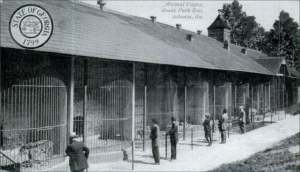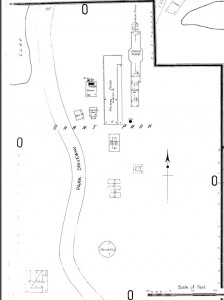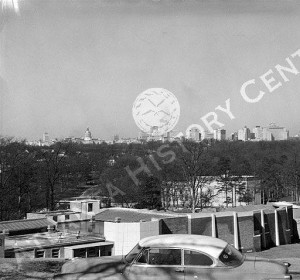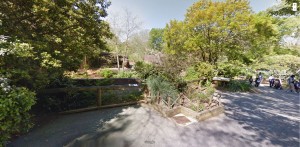Zoo Atlanta has gone through different periods of being a top Zoo in the nation. From either being one of the first Zoos in the United States in 1889. To then being one of the first Zoos to have a gorilla. Then in the more recent period being one of four Zoos in the United States to have pandas. What happened between these different show casing is one of many rebuilding projects, as the Zoo has nearly fell apart during multiple different periods. This is the story behind those different phases.

Jennifer Cuthbertson and Phillip Cuthbertson, “Historic Grant Park”. Georgia: Arcadia Publishing, 2011. 30
In the early summer of 1889 a travelling circus stopped in the City of Atlanta after the owner of the circus underwent some legal troubles. After some money issues, the owner of the material used for the circus went away to Chicago. Leaving all parts of the circus stranded in the city of Atlanta. Nearly all employees of the circus acts left to find other work, and the circus was left with its assets sitting in the Atlanta railroad yard. After concern was brought into attention of the Atlanta public by a newspaper article, the remaining possessions of the circus was bought out by an Atlanta businessman. The businessman then donated a portion of the circus to the city of Atlanta. This portion was moved and was cited as having three lions, a gazelle, two monkeys, a hyena, a jaguar, and a black bear, among many other exotic animals.[1] These new residents of the city were given a home in Grant Park and under the city’s guidance was named the Grant Park Zoo.

Corner of Parkway Driveway and Cherokee Ave, Atlanta 1911-1925, Sheet 528, Sanborn Fire Insurance Maps
Nine years later a writer for the Atlanta Constitution made a trip to the Zoo to give an update on how it was doing. In this article The Constitution gives the Zoo a glorious review of the improved conditions under the new parks superintendent, H.D. Austin.[2] The article hints that prior to Austin’s stretch as superintendent the Zoo was starting to become a bad environment for the inhabitants of the park. Even to the point of discussing certain animals missing from exhibits due to them dying under the previous superintendent’s care. The general tone of the newspaper article is positive, ending with a nice wrap up.
“Everywhere in the park there is an air of cleanliness, and when the springtime comes and the flowers bloom and the green leaves put out Grant Park will be more than ever a public resort of which the people of the city are justly proud.”[3]
This nice editorial by the newspaper was one that helped save the Zoo as the city commission was not pleased to have to be required to fund this new city attraction. For the next eighty years the Zoo would go back and further from the city wanting to close the Zoo to use the money required for up keep on other causes, to the city or private investors expanding the Zoo’s animal collection. In one of the early stages of plans to close the Zoo, “one of the (commission) members went so far as to make a “modest proposal” that the animals be killed and stuffed and used to decorate city council chambers.”[4] However, while these kind of proposals were going on, a number of private investors were donating their own animals to the Zoo, as well giving money to make better conditions for the animals. These better conditions, however, were nothing modern standard. Most animals were not allowed outside small cages until huge reform in the eighties.
Historian Francis Desiderio writes on the transformation of Atlanta’s Zoo. “The Zoo was initially a site for viewing curiosities in a cage.”[5]
With a healthy relationship with the local newspapers and local investors the Zoo was able to maintain enough publicity to keep from getting shut down. Then starting in the early 1930s an Atlanta resident, Asa Candler, had a private wild animal collection that was starting to get too large for its own good. So by the mid-1930s Asa Candler, co-founder of Coca-Cola, negotiated a deal to donate his impressive animal collection to the City to be relocated to the Grant Park Zoo. However, this was the first step backwards for the Zoo, as Candler’s collection was much larger than that of the Zoo. This was a problem as the Zoo could not raise enough money to build new enclosures before Candler delivered more animals, causing the Zoo to quickly become over-crowded. Which eventually lead to animals getting sick and even them getting injured due to attacking each other, as their cages were too close to each other.[6] This story of overcrowding and little funding plagues the Zoo for decades to come. With the arrival of new animals, new funding had to be secured, however the amount needed was never met.
This slow decline of the Zoo was turned around in the mid-1980s by one man and his dedication to making the Zoo a better place. After the National Zoo accreditation committee found Zoo Atlanta to not be up to par with the rest of the Zoos in the United States, it lost its accreditation in 1984. That summer a professor at Georgia Tech decided to volunteer over the summer at the Zoo while he did not have classes to teach, thinking it would be fun to get out. By June of that summer Terry Maple had accepted the job as interim director of the Zoo. Maple was placed in this position after he proved that he had a vision for the Zoo and was willing to put in the effort to make the Zoo better. Within four days of his promotion Maple was setting ground rules for the staff of the Zoo, and making it clear that he was there for one purpose only: To make the Zoo better for the animals, and give a better experience to the visitor. Maple also had a deal with Mayor Andrew Young, and ensured that Zoo would receive a grant that would allow Maple enough lead way to start to fix the problems associated with the Zoo.[7] These problems were not small; The Zoo had recently been named one of the worse ten Zoos in the United States by the Humane Society of the United States.[8] The Zoo was so bad that the Los Angeles Times newspaper wrote, “There was a time when the Atlanta Zoo was regarded as a kind of animal concentration camp. One keeper ate rabbits from the petting Zoo, and other animals lived and died there in unnatural way,”[9] Having received national attention for the horrid conditions for the Zoo, Maple had a lot of ground to cover get Zoo Atlanta to be one of the top Zoos again. His early efforts were rewarded with a $50 million grant from the city. Maple had a few simple ideas that he knew would turn the Zoo around. Ten days after receiving the interim director positions he told the Atlanta Constitution his 5 step process to make the Zoo again. It was as follows:
-“Establish an educational elephant show, because they will become a major attraction at the Zoo.
-Restrict public access to the feline house, and allow spectators to only see felines when they are outside, while also moving to have the big cats have more time outside. Instead of spending their vast majority of their time in cramped cages.
-Improve landscaping, because the Zoo lacked shrubbery and Maple wanted to turn the Zoo into a garden location for residents.
– Move back the railing in the primate house. Maple worked with primates at his time from Georgia Tech, and knew that in order to keep them from getting stressed out they needed more space between them and the Zoo visitors.
– Exhibit fewer animals in more space. This was the most progressive of all the steps, as it required moving a decent amount of the Zoos population to other Zoos, as well as creating much larger exhibits for animals.” [10]
With just these few small changes Maple was quickly given a larger grant from the city to further improve the Zoo, as the ticket sales went up and more people from the city came into the Zoo. This increased park attendance caught the eye of many other investors, one of interest being the Ford Motor Company gave a grant to the Zoo. This money was given to Maple so he could personally bring a team of Zoo employees and designers with him to Africa to look at how certain African breeds live in the wild, so they would be able to construct the most accurate African Plans habitats.[11] This trip in 1986 paid huge dividends as the African Plains exhibit at the Zoo is one of the largest in the Zoo still to this day, hosting a variety of animals, such as: lions elephants, meerkats, warthogs, eastern bongos, giraffes, zebras, and ostrich. Just the new lion enclosure is a vast improvement of the previous cages, as seen above.
With this renewed interest in the Zoo, the Zoo has been slowly having its early budget increase every year. Starting at a little less than $1 million in 1984 to a little over $7.7 million in 1990. Giving Maple a lot more budget to expand on his plan, where he has made Zoo Atlanta once again one of the top Zoos in the United States.[12]
The success of Maples efforts were pushed to a new limit when a panda exhibit was looking to relocate somewhere out of China. Hearing news of this the Zoo, along with the help of the city pushed to secure these pandas, and to give them a new home in Zoo Atlanta. This set forth what will become known as Panda-Mania for the city of Atlanta.[13] Which came full circle when a pair of pandas made their way to the zoo in 1999. Where they have turned out to be a great success, peaking at the birth of the first Panda born in the United States for the past seven years in 2006.[14]
[1] “The Stranded Circus”, The Atlanta Constitution, March 28, 1889: 5
[2] “A Visit to the Local Zoo”, The Atlanta Constitution; Feb 2nd 1898; 7
[3] ibid.
[4] Francis, Desiderio . “Raising the Bars: The Transformation of Atlanta’s Zoo, 1889-2000”. Atlanta History: A Journal of Georgia and the South: Winter 2000, 16
[5] Desiderio, Francis . “Raising the Bars: The Transformation of Atlanta’s Zoo, 1889-2000”. Atlanta History: A Journal of Georgia and the South: 10
[6] Desiderio, Francis . “Raising the Bars: The Transformation of Atlanta’s Zoo, 1889-2000”. Atlanta History: A Journal of Georgia and the South: 21
[7] “Zoo Director Lays Down Groundrules,” Atlanta Daily World , June 19th, 1984; 1
[8] Charles Seabrook, “Atlanta’s Zoo Rated in Bottom 10”, The Atlanta Constitution, Feb 15, 1984; 1
[9] Debbie Newby, “Atlanta Zoo, Once an Animal Concentration Camp, Gains Some Respect,” Los Angeles Times, August 12, 1990. Accessed April 10th, 2016. http://articles.latimes.com/1990-08-12/local/me-873_1_Zoo-atlanta
[10] Ron Taylor, “Maple maps changes at Zoo,” The Atlanta Constitution, June 25th 1984: 6
[11] “Zoo Director Lays Down Groundrules,” Atlanta Daily World , June 19th, 1984: 1
[12] Newby
[13] “Get Ready For Panda-Mania At Zoo Atlanta’s Beastly Feast,” Atlanta Daily World. April 21, 1996: 8
[14] Dorie Turner, “Atlanta Beauty: Zoo Names New Panda.” The Washington Post. December 15, 2006, Accessed April 26. 2016. < http://www.washingtonpost.com/wp-dyn/content/article/2006/12/15/AR2006121501035.html>



